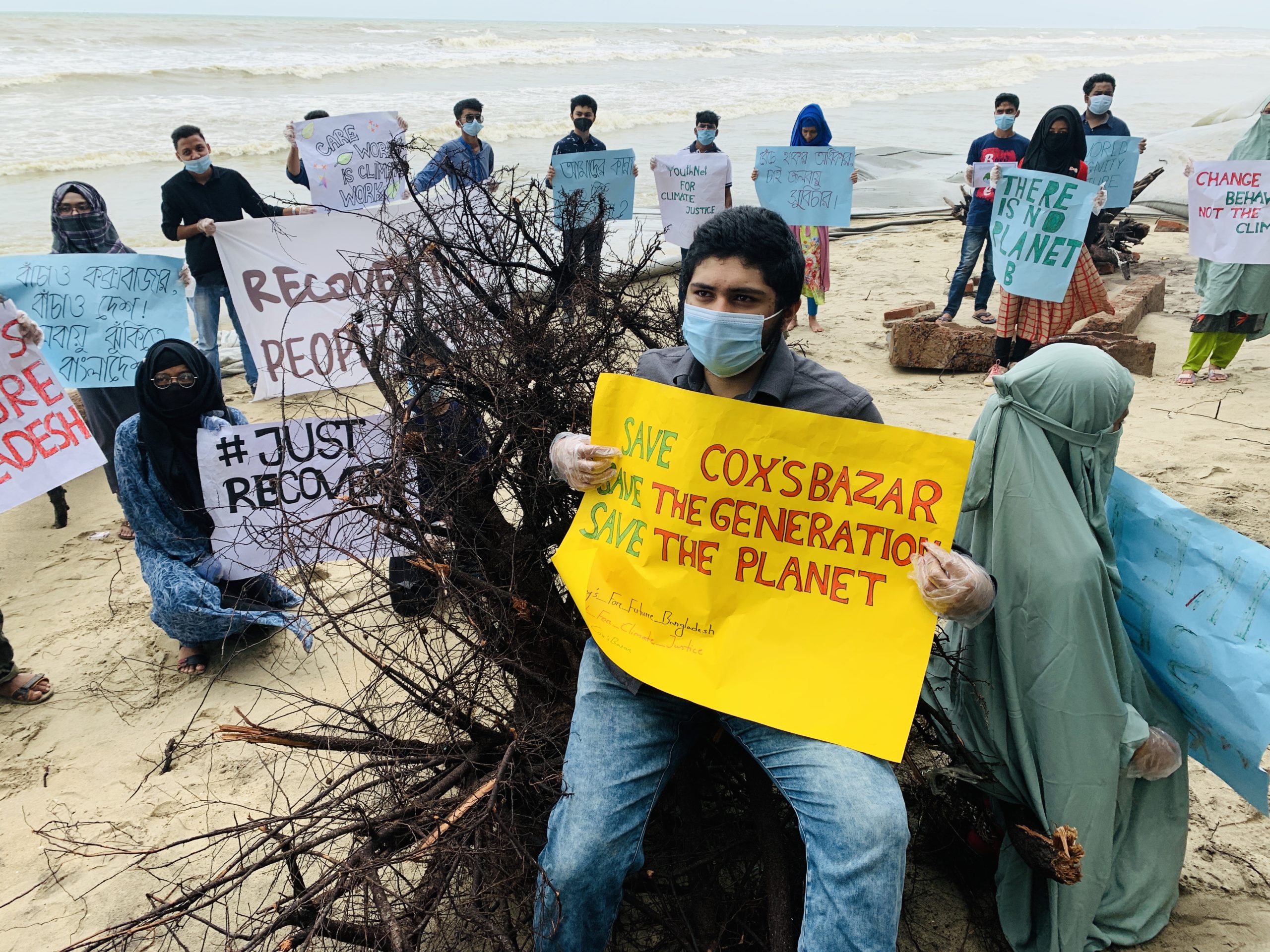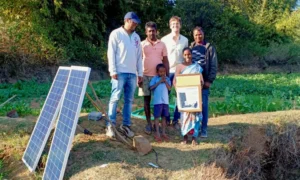Dhaka, Bangladesh
As world leaders pledge to improve the environment and cut down carbon emissions drastically at the 2021 United Nations Climate Change Conference, also known as COP26, which is being held in Glasgow, Scotland, more than 8,000 kilometres away, in Bangladesh, Ayna Rani Sarkar, a victim of climate change, is still living away from her village, longing to go back home.
In May this year, Ayna Rani’s home was washed away by Cyclone Yaas, leaving her and her family without a roof over their heads. Ayna from Gantirgheri village in Koyra upzila in Khulna district, had to take shelter on the embankment where she still lives nearly six months later. She has no home to go back to.
Hundreds of people like Ayna Rani continue to be homeless after Cyclone Yaas hit the country, a large part of which lies in the Ganges delta. The coastal region of Bangladesh, inhabited by the poorest of the poor, has been hit by a series of cyclones, which seem to be getting more ferocious and frequent. Ayna’s upzila was devastated by Cyclone Yaas in 2021, Cyclone Amphan in 2020, Cyclone Fani and Cyclone Bulbul in 2019.
Also Read: Cyclone Amphan’s anniversary of despair
Gantirgheri village has been under water ever since Cyclone Yaas hit it six months ago. Anita Rani Mandal and Karuna Rani Thander, like Ayna Rani, are still struggling to bring some semblance of normalcy into their lives, while their menfolk go out to look for work.
While the voices of the poor climate victims of Gantergheri, Gabura, Pratapnagar or Kurikahunia villages of Bangladesh are yet unheard by the world community, COP26 brings a glimmer of hope. Climate activists in Bangladesh are hoping to get their voices heard at Glasgow, and press for climate action and climate justice for villagers like Ayna Rani who haven’t contributed to the problem of climate change but seem to be affected the most by it.
Bangladesh is particularly vulnerable to the impact of climate change as has been seen over the years. Everytime the global temperature rises, the sea levels rise with devastating consequences. Bangladesh has a long coastline, is a low lying land and has high population density making it even more vulnerable to any change in the climate.
The relentless cyclones and floods have affected livelihoods, health and caused displacement of entire villages. Everytime the sea rises, large tracts of its coastal areas are inundated, and sometimes lost forever.
Climate justice demands
Recognising the precarious situation of Bangladesh, young climate activists in the country have taken up cudgels to do something about the at-risk populations, especially in the coastal areas. They are drawing the attention of politicians, policymakers and experts to the horrific problems facing Ayna Rani and so many others like her.
These young activists are highlighting the disasters farmers and fishers encounter year after year because of cyclones and floods; they are talking about women, children and teenagers who are constantly at risk of death and disease because of climate change. They routinely hold area-based consultation meetings with politicians, policymakers, development organisations and experts.
“Many parts of Bangladesh, especially the coastal areas, are facing extreme losses. Climate displacement and migration will continue to raise global security issues. We want justice, fairness and a sense of responsibility from the world community,” Sohanur Rahman, founding member of a grassroots movement called Fridays for Future Bangladesh, told Gaon Connection. Sohanur is also coordinator of Youthnet for Climate Justice, a large youth network working to support coastal communities during humanitarian crises.
“We want the world community to fulfill its promises to reduce carbon emissions and ensure climate funding,” the young activist added.
Also Read: In Deep Waters: Is climate change impacting the reproductive health of women in coastal Bangladesh?
The past few years have seen a surge of activism across the coastal regions of Bangladesh, fighting for climate justice.
Climate programmes announced by Swedish youth climate activist Greta Thunberg are being implemented in the country.
Mujib Climate Prosperity Plan
The vigorous and vociferous climate activism in the country has got government policymakers taking note, and has already had an impact on various government policy plans. In 2019, Bangladesh declared climate change to be a “Planetary Emergency”.
More recently, at COP26 in Glasgow, the Bangladesh government announced the ‘Mujib Climate Prosperity Plan’ that will pave the way for tackling climate change. This plan has been named in honour of the Father of the Nation, Bangabandhu Sheikh Mujibur Rahman.
“This plan is set to guide our development path through a low-carbon strategy. Other CVF [Climate Vulnerable Forum] members will likewise, develop their own such plans of climate resilience to achieve climate prosperity,” Bangladesh Prime Minister Sheikh Hasina said while presenting the plan at COP26.
Also Read: The long walk for potable water in Bangladesh
Back home in Bangladesh, climate activists are already on the move creating, initiating and pushing measures that will immediately help the people in the coastal areas. Side by side they are raising funds both within the country and internationally.
According to Youthnet for Climate Justice, climate workers are working at various locations along the coast to identify the problems and demands of the local people and reach them to the authorities.
In many places, climate workers themselves have taken the initiative to solve climate problems locally. They liaise with the local administration to resolve the issue, and this method of working is showing positive results.
Coal power projects cancelled
One of the significant achievements of the climate activists in Bangladesh has been influencing the government to cancel the contracts for 10 coal power projects.
“If the coal-fired power plant project had taken off, it would have spelt a big disaster to our environment. We did not let it happen,” Jabed Nur Shantaw, a youth climate activist and founder of Climate Justice-Bangladesh, told Gaon Connection. He was at the forefront of the movement against the ‘coal-power project’ in Cox’s Bazar a town in south eastern Bangladesh, renowned for having the world’s longest natural sea beach.
“If we want to save our future generations, we must move away from coal-fired power plants. We need to move towards renewable energy sources. More investment in renewable energy can help our country emit less carbon and protect itself from the effects of climate change,” the youth climate activist declared passionately.
“We have been able to convince the government through this movement. We had discussions with various levels of government officials. After that, we came to know that the government has canceled 10 coal power projects,” Shantaw said, sounding pleased.
Also Read: Three of four people in coastal Bangladesh reduced food consumption during the COVID-19 pandemic
Pulling back from the brink
SM Shaheen Alam from Satkhira district on the southwest coast of Bangladesh is no stranger to the devastation of cyclones and floods. He grew up living through disasters, watching his parents struggle to just survive sometimes, and he became a climate activist himself.
As coordinator for Youthnet for Climate Justice (Satkhira Unit), Shaheen Alam has spearheaded initiatives to tackle the drinking water crisis not just in his village but other villages too. Along with other activists he has, among other things, planted trees to prevent the embankments from being washed away.
“There is tremendous loss of life and property in the area where I live. At the local level we are trying to solve problems on a limited scale,” the young activist said. “We want the implementation of the Paris Climate Agreement. We want the consensus of the world community to limit the rate of global warming to 1.5 degrees Celsius. Only then will our climate problem be solved on a large scale,” Shaheen Alam added.
Also Read: Villagers in Bangladesh build ‘jungla dams’ using wood and bamboo to prevent land erosion
“It is the young people who are going to face the consequences of climate change much more than we are. Climate change and its related disasters are more real for them,” AKM Mamunur Rashid, climate specialist, UNDP-Bangladesh pointed out to Gaon Connection. “They are the ones who must be given the chance to understand, plan and take decisions about climate change. If we do not put them in a leading role, it will be intergenerational injustice on our part,” he continued.
According to Mamunur Rashid, it was the need of the hour to ensure that the strong young voices, especially from the vulnerable population speak out loud and clear and be heard in decision making forums nationally and internationally.
Training the youth
UNDP-Bangladesh, British Council-Bangladesh, Action Aid-Bangladesh, Change Initiative are some of the institutions working to train and empower the youth to tackle climate change.
UNDP-Bangladesh is engaging youth in climate risk assessment, local adaptation planning and climate change adaptation tracking. They want the youth to transform the economy and society into a low carbon climate resilient economy and society. And the young activists are already on the job.
Under the guidance of UNDP-Bangladesh, climate activists have conducted an audit of a climate tolerance project implemented by the Union Council and submitted a report on the project. Youthnet for Climate Justice is doing the same.
Also Read: The ‘hanging village’ of Bangladesh: A glaring reminder of climate change refugees
“We are helping farmers in Rangabali upazila of Patuakhali district in coastal Bangladesh to cultivate paddy. As a result of climate change, many people had stopped paddy cultivation due to losses. But now, with our help, they have returned to it and are getting a good yield,” Kalu Talukder, a youth climate activist trained by UNDP-Bangladesh, told Gaon Connection.
The British Council and ActionAid Bangladesh are also trying to reach out to the policy makers through the young climate activists to address a variety of climate-related issues.
The young voices are getting louder, said Saleemul Huq, director of the International Climate Science and International Center for Climate Change and Development (ICCCAD).
“Bangladesh youth have become very active in the last few years in publicising the impact of climate change in the country. They have been very active in social media like Twitter and Facebook. Some have also attended international meetings and they are being heard globally,” Huq said. “At the national level the youth groups have interacted very effectively with the Parliamentary Committee on Climate Change and Environment to help implement their resolution declaring the Planetary Emergency’,” he added.
The hard work of the young climate activists has paid off. The Sixth Assessment Report of the United Nations Intergovernmental Panel on Climate Change (IPCC), released in August this year, carries the voices of Ayna Rani Sarkars of the world who are climate-endangered.
The IPCC report was compiled by 134 scientists from 66 countries.
The people of coastal Bangladesh, like Ayna Rani, have survived extreme weather conditions for more than a decade. Their livelihoods are gone and so are their homes, they have no savings and hundreds of them remain displaced.



















